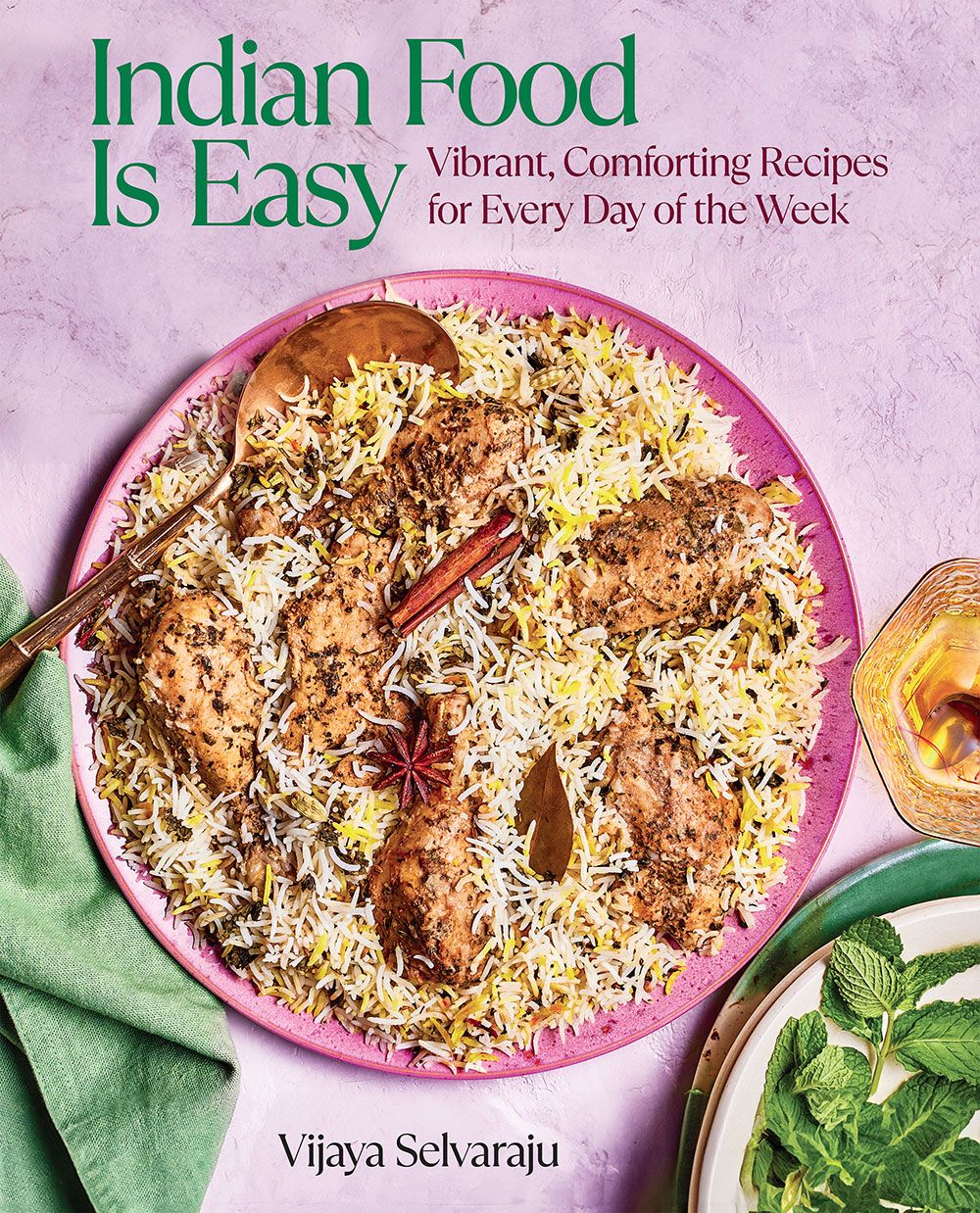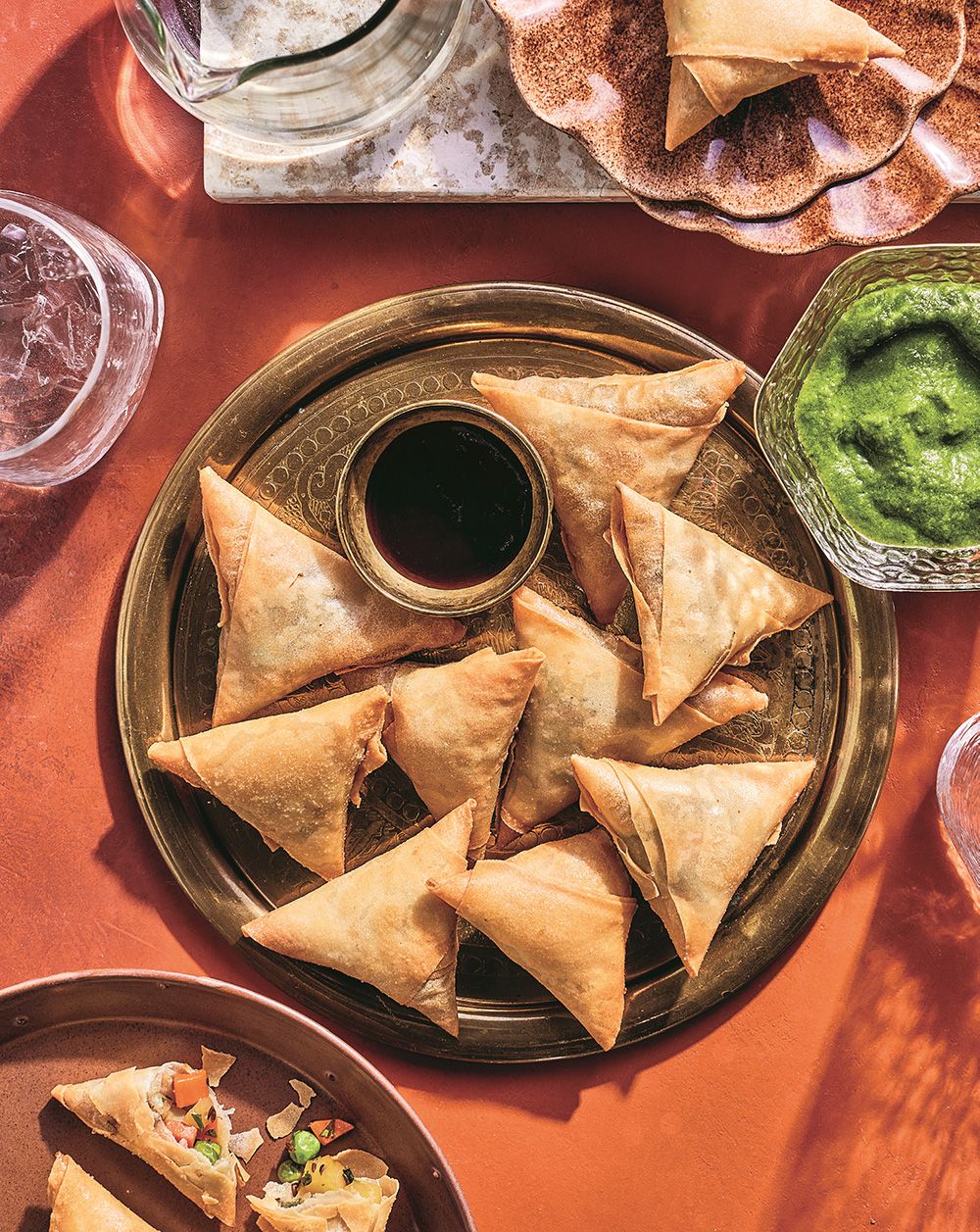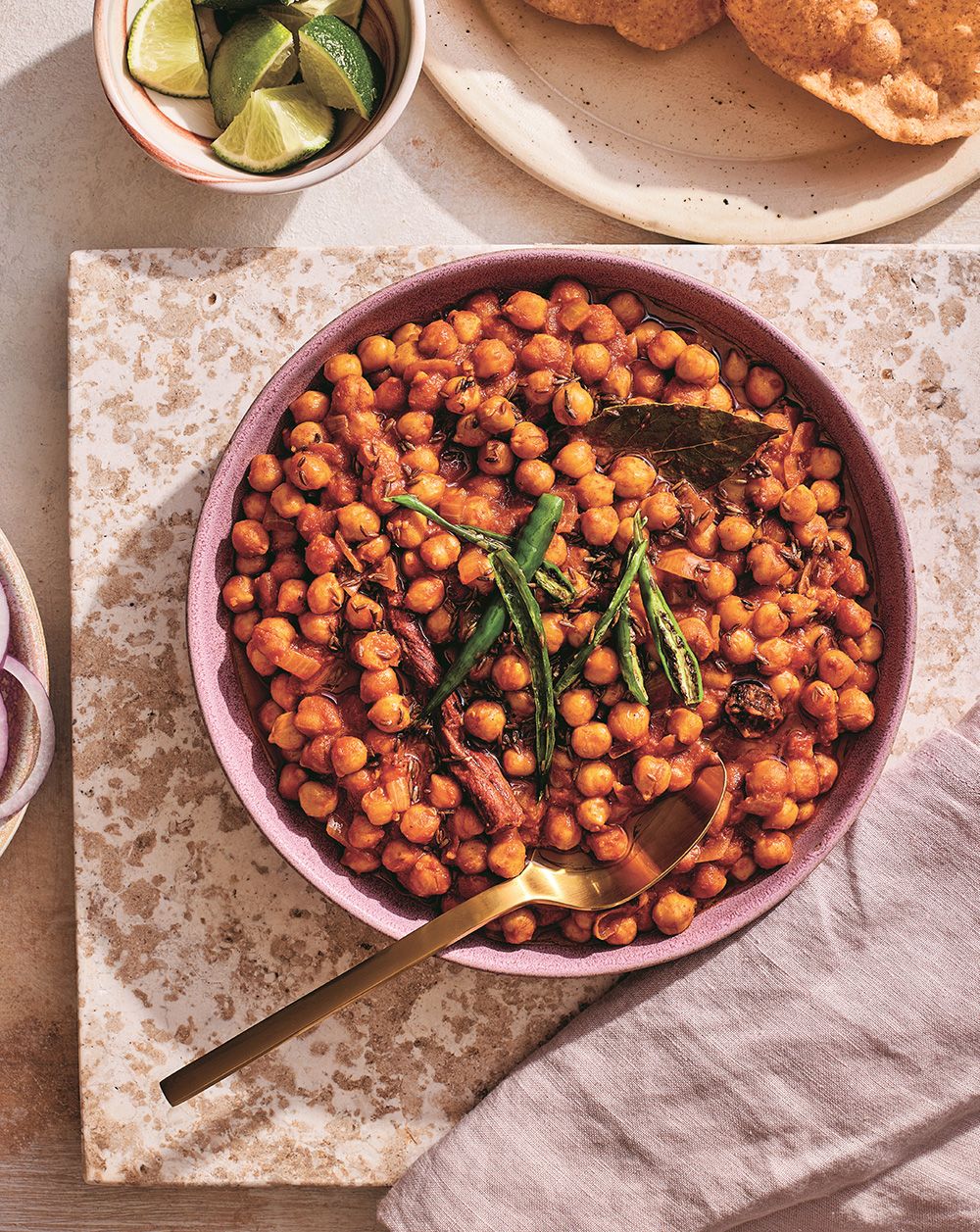Reviews and recommendations are unbiased and products are independently selected. Postmedia may earn an affiliate commission from purchases made through links on this page.
Our cookbook of the week is
by Toronto-based TV personality, food media producer, author and cooking expert Vijaya Selvaraju.
Jump to the recipes:
“the best”
, easy
and 30-minute
(chickpea curry).
was a self-described “kid of Food Network.” Today, the Toronto-based TV personality, food media producer, author and cooking expert makes regular appearances on shows such as The Good Stuff with
. Growing up, she watched more food TV than cartoons, soaking up as much knowledge as possible from her culinary heroes.
“When you’re young, you’re able to absorb a lot. So, even if I didn’t actually get to do all the things that they did on TV, perhaps a fraction of those things, I felt like a lot of that knowledge, just based on pure interest, was being absorbed into my brain at a rate that I couldn’t completely comprehend. But it was all good stuff. And so, I think when I was 10 years old, I would talk about chiffonading basil,” says Selvaraju, laughing.
Selvaraju’s mother, Meena, founded a South Indian
more than 25 years ago. She helped out her mom where she could, which added to her passion for food.
After graduating with a Bachelor of Business Administration from the University of Toronto, Selvaraju started a food blog and a
in the late 2000s. When one of her first recipe videos,
, got millions of views, Selvaraju knew she was onto something. What made the views even sweeter was that people weren’t just watching the video — they were making the dish.
“The comments of people reporting back, and the people writing in forums about this chicken tikka masala, it was just unreal to me. But it’s steeped in simplicity, not overcomplicating things, because Indian cuisine doesn’t have to be complicated,” she says, adding that her teaching style is rooted in the philosophy, “If I can do it, you can do it, too.”
Her career as an on-screen expert began roughly a decade ago, with appearances on The Marilyn Denis Show, which led to a hosting role on Gusto’s flagship series, One World Kitchen.
Selvaraju considers herself “a world cuisine person.” For many years, she relied on Meena to cook all the Indian meals at home. “She already had that covered, so let me take care of the rest.” One World Kitchen was Selvaraju’s first foray into Indian cuisine, where she explored food from all over the country. She soon discovered she had learned more from her mom than she realized.
“It was just being in the environment, observing her, smelling the smells, tasting the food. I had a good sense of taste, too.”
Selvaraju began sharing more and more Indian recipes, which tended to resonate with young people, especially those from the Indian diaspora who, like her, enjoyed cooking but were accustomed to their parents providing home-cooked meals.

“Something in my brain clicked to say, ‘That’s cool. That’s really nice, but there’s something to be said for, ‘Why are we not learning to make these dishes ourselves?’ And what’s the barrier to entry there, apart from the comfort of having your own parent cook these dishes?”
Inspired to break down the obstacles, Selvaraju channelled the time-saving tips and tricks she picked up from her mom, “to make things a lot more efficient without compromising on flavour, taste, quality, and, of course, most importantly, tradition,” into her cookbook debut, Indian Food Is Easy.
Stocking the pantry with passata, a shortcut to making tomato-based curries, and using a multi-cooker, such as an Instant Pot, are just two of the tips she shares in the book to help cooks make Indian dishes with less time and effort.
The book features 100 recipes, including dishes from different parts of India and “mash-ups” that reflect how Selvaraju frequently cooks at home, merging Indian flavours with other cuisines, such as palak paneer lasagna, cheesy keema quesadillas and jaggery apple blossoms.
“That was really important for me,” she says. “Because often, we have leftovers or curries that we want to transform into something else. And so, I wanted to have different dishes that we’re already familiar with in North American cuisine, that you can merge those flavours with.”
Selvaraju notes the discrepancy between the number of people who appreciate eating Indian food — whether made by their parents or at restaurants — and those who cook it at home.
“I think there’s even more of a desire to say, ‘I want Indian food to be a staple in my household, not for just once in a while, but for every day.’ And it goes beyond Indian people or people from South Asia. Being able to recreate these flavours at home is really, really exciting.”
, one of Selvaraju’s
on YouTube, is a case in point. She stripped it back to basics, removing the complexity — and the onions, garlic and ginger, which shocks some people.
Viewers often comment, “It tastes like my favourite Indian restaurant’s butter chicken,” or, “It tastes better than the one I get, and I can’t believe I did it myself.” For Selvaraju, that’s the best part. “When someone makes a recipe, and they say, ‘I can’t believe I made that myself,’ I know my job is done.”
THE BEST BUTTER CHICKEN
Serves:
4
For the chicken:
1/2 cup plain yogurt
Juice of 1 lemon
2 tsp garam masala
1 tsp Kashmiri chili powder
1 tsp ground coriander
1 tsp ground turmeric
Kosher salt
1 1/2 lb (680 g) boneless skinless chicken thighs, cut into bite-sized pieces
3 tbsp ghee
For the sauce:
1/2 cup unsalted butter
2 cups strained tomato sauce (passata)
1 tbsp sugar
1 tsp Kashmiri chili powder
1 1/2 tsp garam masala
2 tbsp kasoori methi, divided
Kosher salt
2 cups whipping (35 per cent) cream, plus more for garnish
Step 1
To make the chicken, add the yogurt, lemon juice, garam masala, chili powder, ground coriander and turmeric to a bowl. Season with salt to taste and mix until well combined. Add the cut chicken thighs to the yogurt mixture and stir to coat. Cover and marinate for 10 minutes at room temperature.
Step 2
Heat a large pot or Dutch oven on medium-high heat. Once hot, add the ghee and arrange the marinated chicken evenly in the pot, ensuring not to crowd the pot and working in batches if necessary. Brown the chicken for 2 to 3 minutes on each side, then transfer to a bowl. The chicken does not need to be cooked all the way through at this point.
Step 3
To make the sauce, reduce the heat to medium and add the butter, strained tomato sauce, sugar, chili powder, garam masala and 1 tablespoon of the kasoori methi to the pot, and season with salt to taste. Cook on medium to medium-low heat, stirring often, for 15 minutes or until the tomatoes have reduced to a jammy consistency and the fats in the pot begin to sizzle along the edges.
Step 4
Pour in the cream and mix until a creamy blush-coloured sauce forms. Bring to a simmer and add the chicken. Simmer, stirring occasionally, until the chicken has completely cooked through, about 10 minutes.
Step 5
Transfer to a serving dish and garnish with a drizzle of cream and a sprinkling of the remaining 1 tablespoon kasoori methi.
Step 6
Serve with peas pulao and naan.
EASY MIXED VEGETABLE SAMOSAS

Makes:
30 samosas
2 tbsp canola oil, plus more for deep frying
1 tbsp cumin seeds
1 medium onion, finely chopped
1 medium russet or Yukon gold potato, peeled and diced (about 2 cups)
1 small carrot, peeled and diced
1/2 cup water, divided
Kosher salt
1/2 cup frozen peas
1/4 cup chopped fresh coriander (cilantro)
1/4 cup all-purpose flour
20 frozen spring roll wrapping sheets (about 10 x 10 inches/25 x 25 cm), thawed
1/2 cup mint coriander chutney, for serving
1/2 cup tamarind chutney, for serving
Step 1
Heat 2 tablespoons of the oil in a frying pan on medium-high heat. Add the cumin seeds and let them toast and crackle for 15 seconds. Add the onion and sauté until it has softened, 3 to 4 minutes. Add the potato and carrot to the pan, and sauté for 2 to 3 minutes. Add 1/4 cup of the water, season with salt to taste, stir, and cover with a lid. Cook for 5 minutes. Most of the water should be absorbed by the vegetables at this point.
Step 2
Remove the lid from the pan and add the frozen peas. Cook for 1 minute, until the peas have warmed through. Remove the pan from the heat and stir in the fresh coriander. Allow the mixture to cool for 10 minutes.
Step 3
Place the flour and the remaining 1/4 cup water in a small bowl and mix to form a thick paste.
Step 4
Cut the stack of thawed spring roll wrapper sheets into 3 even rectangles, about 3 1/4 x 10 inches (8 x 25 cm) each. From 1 rectangle, peel away 2 sheets together to form the pastry for the samosa. Store the remaining sheets under a damp cloth to prevent them from drying out.
Step 5
Lay the pastry horizontally on a clean surface. Fold the pastry down the middle vertically to create a crease in the centre. Open the pastry back up and take 1 corner of the pastry rectangle and bring it toward the crease, forming a triangle. The edge of the pastry should align with the crease. Spread the flour paste along the edge of the pastry that forms the triangle, then fold over the other corner of the pastry to form a cone.
Step 6
Add 1 to 2 tablespoons of the filling to the cone. Fold over the remaining pastry to create a triangle, and seal the edges with the flour paste. Repeat with the remaining filling and samosa wrappers.
Step 7
In a deep frying pan or wok, heat 3 inches (8 cm) of oil to 350F (177C). Fry the samosas in batches for 4 to 5 minutes, gently flipping once or twice during frying, until crispy and golden.
Step 8
Drain on a paper towel. Serve hot with both chutneys.
30-MINUTE AMRITSARI CHOLE

Chickpea Curry
Serves:
4
2 1/2 cups water
2 black tea bags (Assam, breakfast, Ceylon or Darjeeling)
3 tbsp canola oil
1 bay leaf
1 cinnamon stick
3 green cardamom pods
1 black cardamom pod (optional)
3 cloves
1 medium yellow onion, finely chopped
4 cloves garlic, finely grated
1/2 tbsp finely grated ginger
1 cup strained tomato sauce (passata)
1 tsp Kashmiri chili powder
1 tsp garam masala
1 tsp kasoori methi
1 tsp ground coriander
1 tsp amchur powder (optional, see note)
1 tsp anardhana (dried pomegranate) powder (optional, see note)
1/2 tsp black salt
1/2 tsp ground turmeric
1/4 tsp asafoetida
Kosher salt
2 cans (19 oz/540 mL each) chickpeas, drained and rinsed
2 tbsp ghee
1 tsp ground cumin
3 long green finger chilis, split lengthwise
Step 1
Add the water to a small saucepan and bring it to a boil. Add the tea bags and continue boiling for 3 minutes or until the water takes on a dark brown hue. Remove from the heat and discard the tea bags.
Step 2
To a large pot on medium heat, add the oil. Once hot, add the bay leaf, cinnamon stick, green cardamom, black cardamom and cloves. Sauté for 10 to 15 seconds or until the cloves puff up. Add the onion, garlic and ginger and sauté until softened and fragrant. Pour in the strained tomato sauce and continue cooking for 10 to 15 minutes, stirring frequently, until the tomatoes become jammy and the oil begins to sizzle along the edges of the mixture.
Step 3
Add the chili powder, garam masala, kasoori methi, ground coriander, amchur powder, anardhana powder, black salt, turmeric, asafoetida and salt to taste. Mix to combine. Add the drained chickpeas and tea water. Increase the heat to medium-high and simmer for an additional 10 minutes to slightly thicken. Transfer to a serving bowl.
Step 4
Add the ghee to a small frying pan on medium-high heat. Once hot, sprinkle in the cumin and add the chilis. Cook for 10 seconds and then pour over the prepared chole. Stir to mix in. Serve hot with pooris, kulchas, chapatis or peas pulao.
Note:
In case amchur and anardhana powders are not available, stir in the juice of 1/2 large lemon at the end of cooking, before the addition of the spiced ghee.
Recipes and images excerpted from
by Vijaya Selvaraju. Copyright ©2025 Vijaya Selvaraju. Photographs by Tanya Pilgrim. Published by Appetite by Random House®, a division of Penguin Random House Canada Limited. Reproduced by arrangement with the Publisher. All rights reserved.
Our website is the place for the latest breaking news, exclusive scoops, longreads and provocative commentary. Please bookmark nationalpost.com and sign up for our cookbook and recipe newsletter, Cook This, here.








